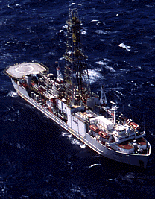JOIDES Resolution

JOIDES Resolution Tour: JOIDES Resolution
Cross-section of the JOIDES Resolution
The "JOIDES" in the ship's name stands for Joint
Oceanographic Institutions for Deep Earth Sampling. The name
reflects the commitment of the program's international
partners. The "Resolution" honors an earlier ship,
the HMS Resolution, commanded more than 200 years ago by
Capt. James Cook, who explored the Pacific and Antarctic regions.
LABORATORY FACILITIES
The heart of this floating scientific research center
features seven stories of laboratory facilities. The ship
dedicates more than 12,000 square feet of space to
scientific laboratories and equipment. The laboratories
contain facilities for studies in sedimentology,
paleontology, geochemistry, geophysics, petrology,
paIeomagnetism, physical properties, and downhole
measurements. Computer systems and photographic facilities
lend critical technical support. A marine geophysics
laboratory produces digital, single-channel seismic
reflection profiles while the ship is under way.
DYNAMIC POSITIONING SYSTEM
A positioning system, supported by 12 powerful thrusters,
uses computers to maintain the ship over a specific location
while drilling in water depths up to 8,200 meters (5 miles).
The ship can suspend as much as 9,150 meters of pipe to
obtain core samples. The 400-ton heave compensator keeps the
drill string stable relative to the ocean floor.
The ship was built in 1978 in Halifax, Nova Scotia. In 1984,
ODP converted it into a floating scientific research center.
An ice-strengthened hull allows it to drill in high-latitude
seas.
![]()
![]()